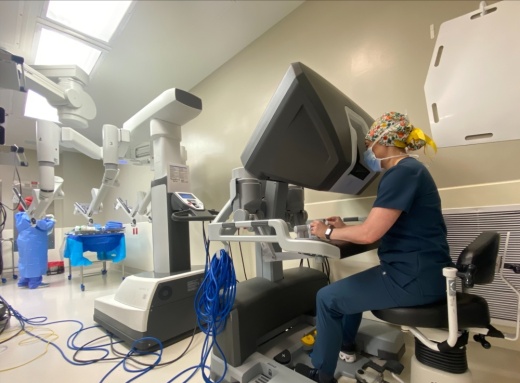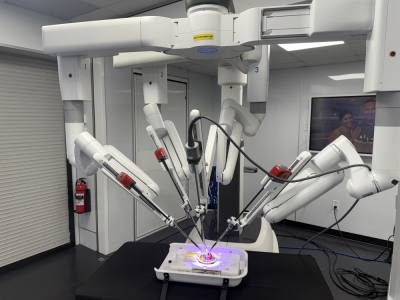The VELYS robot is one of many new robotic technologies that have made their way into health care facilities in Central Texas. Major hospital systems, including Baylor Scott & White, Ascension Seton and St. David’s, are increasing their investments in robotic procedures.
The two-minute impact
Dell Children’s North, located near Cedar Park, began using the VELYS robot to perform spinal surgeries for children in the area this summer. The 3D imaging technology allows surgeons to more accurately place and drill screws in a patient’s back that may be needed to correct scoliosis or other spinal deformities.
“You have technology that’s not available anywhere else in the world for pediatric spine surgery,” Dell Children’s President Adam Messer said. “You can have care delivered right here close to home and be confident that it’s the best available anywhere.”
The technology is positioning Dell Children’s North to become “a destination center for pediatric spine surgery,” said Dr. Kirsten Ross, a pediatric orthopedic surgeon at Dell Children’s.
“The idea ... is to elevate the care and the capabilities that are delivered to those northern communities and to put Dell Children’s North on the map as a complex spine center of excellence,” Messer said.
Surgeons can use robotic technology to perform minimally invasive surgeries with faster recovery times, allowing doctors to treat more people, said Dr. Thomas Payne, vice president of the Texas Institute for Robotic Surgery at St. David’s.
“You do not have to leave Austin to get any spine or scoliosis care. We can do everything here.” Kaufman said.
The local impact
St. David’s: 125,000 robotic procedures performed since 2015 through St. David’s HealthCare
Local branch:
St. David’s North Austin Medical Center
12221 N. Mopac, Austin
Ascension Seton: 25,000 robotic procedures performed by Ascension Texas since 2021
Local branch:
Ascension Seton Northwest Hospital
11113 Research Blvd., Austin
Dell Children’s: 250 robotic procedures performed at Dell Children’s Central since fiscal year 2023-24
Local branch:
Dell Children’s Medical Center North Campus
9010 N. Lake Creek Parkway, Austin
Zooming out
The implementation of robotic surgical procedures has taken off across the United States.
Ascension Seton, Baylor Scott & White and St. David’s HealthCare have expanded robotic surgeries across their hospitals in specialities ranging from general surgery to orthopedics.
“[Robotics] is definitely becoming the most dominant way of operating, and it’s definitely the superior way to operate, but we’re just really getting started,” Payne said.
By the Numbers
- More than 750,000 robotic surgeries are performed in the U.S. every year, according to Stony Brook Medicine.
- Robotic surgeries increased from 1.8% to 15.1% from 2012 to 2018, according to the American College of Surgeons.
How it works
After years of providing robotic surgeries for urology and gynecology, robotic orthopedic spinal surgery is “the new frontier” for Ascension Seton, said Charles Kaczmarek, vice president of surgical services for Ascension Seton.
Doctors perform surgery to correct scoliosis by placing screws and rods into a patient’s back, Kaufman said. The VELYS robot completes a 3D scan of a patient’s spine and uses a robotic arm to position the screws. The precision of the robot is crucial as misplacing a screw can result in a spinal cord injury, Kaufman said.
“[It allows] us as the surgeons to do this with less force, less variance and more safety, but we are still doing everything,” Kaufman said.
The VELYS technology allows Dell Children’s to take on more complex spinal cases, Ross said. Additionally, the robot makes spinal surgeries more efficient and reproducible whereas the outcome of nonrobotic spinal procedures can differ based on the surgeon, she said.
Spinal procedures using the VELYS technology, which began June 5, were already booked for six weeks out as of mid-May, Ross told Community Impact.
“Our goal is to continue to be the leader in the robotics access for the region,” said Dr. Travis Isbell, chair of surgery for Baylor Scott & White. “We want to keep pushing that availability so that we can give the patients all the best options right in front of them.”
Benefits of Robotic Surgery
- Smaller incisions
- Faster recovery times
- Reduced risk of blood loss and infection
- Lower hospital readmission rate
- Lower use of narcotics
SOURCE: Baylor Scott & White, Ascension Seton
The impact
Founded in 2011, St. David’s Texas Institute for Robotic Surgery has trained surgeons on how to perform procedures using robotic technology nationwide. The institute has piloted the expansion of robotics procedures across 180 HCA Healthcare hospitals, Payne said.
“It was the test tube of how to do robotics and how to do it the best in the world,” Payne said about the Austin-based institute. “The best is actually right here in Austin at St. David’s.”
Dell Children’s has invested in robotics technology so Austin-area families can feel confident they are receiving the most advanced care close to home, Messer said.
“It’s an essential component of recovery and thriving after a health care experience to be where you’re familiar and where you’re loved,” Messer said. “When people have to leave Austin to receive health care, it’s a failure on our part as health care leaders.”
Looking ahead
Austin-area hospital leaders and doctors say they expect to see innovations in the industry going forward.
Dell Children’s began using a da Vinci robot for urology procedures at the Dell Children’s Central Campus in December, Messer said. This fall, the hospital plans to onboard a new fetal surgery team to perform in-utero procedures for babies with genetic deformities, he said.
Payne said he expects that surgeons may eventually be able to use dyes to identify cancer, blood vessels and nerves in real time. Doctors may begin consulting other surgeons by teleconferencing into the operating room, Isbell said.
“There will always be human judgment, but that human judgment will be enhanced by all types of computer assistance and artificial intelligence and things that would really make the surgeons much, much better at what they do,” Payne said.






